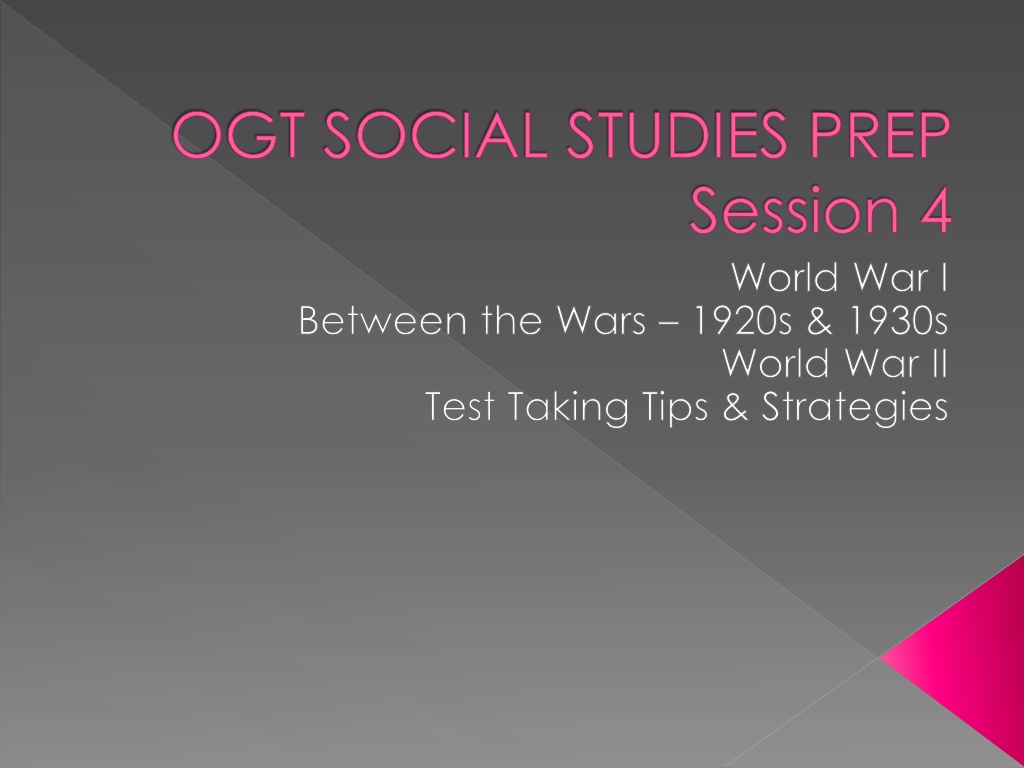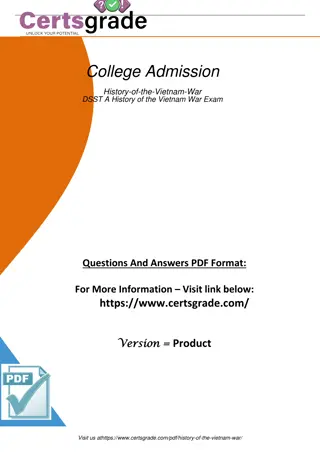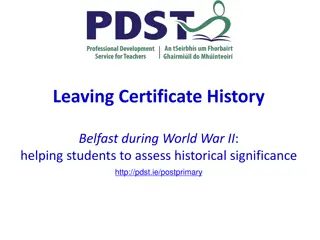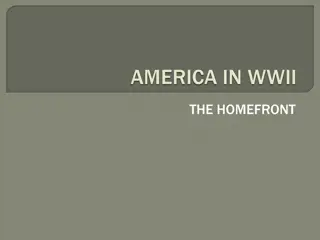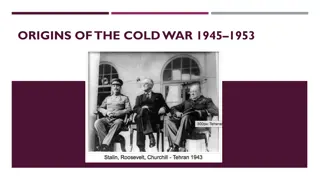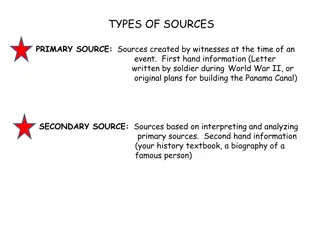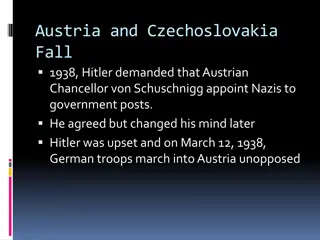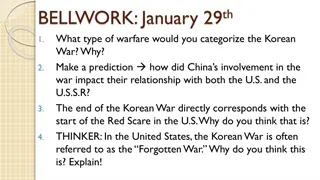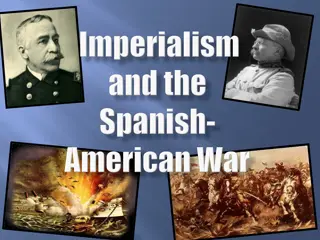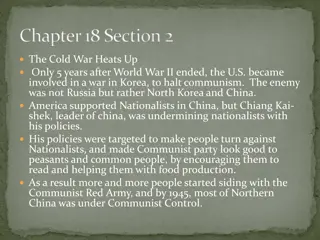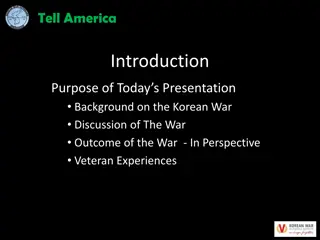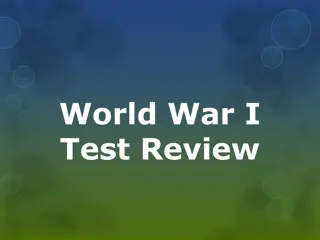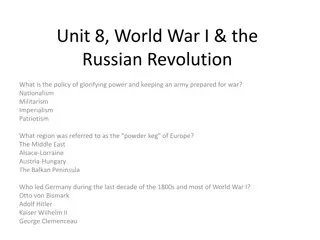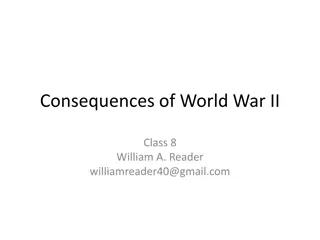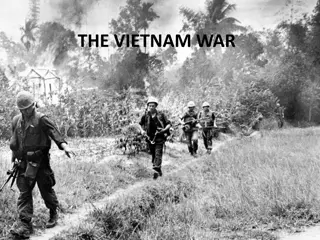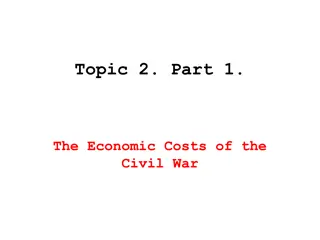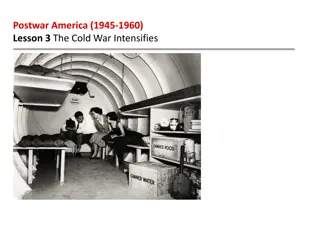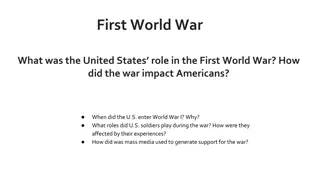The Impact of World War I on Global History
Delve into the multiple causes and effects of World War I, such as militarism, imperialism, nationalism, and alliances. Explore how the global scope of WWI shaped the 1920s and 1930s, leading up to World War II. Gain insights into key events and dynamics of this transformative period.
Download Presentation

Please find below an Image/Link to download the presentation.
The content on the website is provided AS IS for your information and personal use only. It may not be sold, licensed, or shared on other websites without obtaining consent from the author. Download presentation by click this link. If you encounter any issues during the download, it is possible that the publisher has removed the file from their server.
E N D
Presentation Transcript
OGT SOCIAL STUDIES PREP Session 4 World War I Between the Wars 1920s & 1930s World War II Test Taking Tips & Strategies
World War I WWI had multiple causes & effects, arising from militarism, imperialism, nationalism & alliances. The global scope of WWI increased the human costs of war.
World War I New technologies & practices [use of poison mustard gas, trench warfare, machine guns, airplanes (for reconnaissance), submarines, & tanks] affected the outcome of the war WWI was fought mostly in Europe; the United States became one of the Allied Powers.
World War I After the Treaty of Versailles ended WWI, the League of Nations as formed in an attempt to create a forum for peacefully solving disputes between nations. The failure of President Woodrow Wilson s Fourteen Points for peace, along with the refusal of the United States to join the League of Nations, had far-reaching consequences
WWI Causes Imperialism (may also be considered Expansion) By the early 1900s, much of Asia and nearly all of Africa had been colonized by European nations. Colonies provided raw materials and new markets for European manufacturing. Desire to increase their empires led to competition and power struggles among European nations.
WWI Causes Militarism The spread of nationalism in Europe led to a dangerous arms race, in which nations built up their armies (& navies, for some) to maintain equal strength with their neighbors. Britain had the world s strongest naval power. Other European nations built up their navies to be able to compete with Britain. By 1900, Germany had largest & best-trained army in Europe Draft increased the size of army during peacetime.
WWI Causes Alliances (Sshhh Some of them are secret!) Military agreements to protect the other in case of attack. Long chains of allying countries formed. Several countries could be drawn into conflict if one was attacked by one other. Since many of the agreements were secret, attacking country may not know the consequences of their actions until it was too, late.
WWI Causes Alliances Central Powers Germany & Austria- Hungary Later joined by Bulgaria & the Ottoman Empire Allies Great Britain, France, and Russia The United States (eventually) joined the side of the Allies.
WWI Causes - Nationalism Feeling of pride and loyalty people have for their country or for other people who share a common history, language, or culture. Swept the European continent during the 1800s. Rise of nationalism led to minority groups to call for independence Czechs and Slovaks in Austria-Hungary wished to form their own nation Poles wanted an independent Poland had been divided by Germany, Austria-Hungary, and Russia.
WWI Causes Nationalism Bosnia area was part of the Austria- Hungary Empire, but many Serbs lived there. Serbs and Serbia wanted Bosnia to be part of Serbia. Black Hand Gavrilo Princip assassinated Archduke Francis Ferdinand heir to the Austria-Hungary throne. THIS WAS THE SPARK THAT IGNITED ALL THE CAUSES TO EXPLODE INTO WWI.
WWI - Causes The assassination of Francis Ferdinand (a sign of showing nationalism) sparked the alliances into action! European nations were already heated with one another over imperialistic competition. European nations were ready to go to war, due to their militarism efforts. An assassination of one person, no matter what his position, should never be able to lead to WORLD WAR, but everything else was in place, and thus, World War I began.
Which term is defined largely by feelings of intense patriotism? Neutrality Militarism Nationalism Imperialism
Which term is defined largely by feelings of intense patriotism? Neutrality Militarism Nationalism Imperialism If you said NATIONALISM, you would be CORRECT!
WWI Causes - Writing Response Explain how the system of alliances that was formed in Europe before WWI caused most European nations to draw into the conflict.
Possible Answer Alliances were formed between European nations. Many of them were secret agreements. An attack against one nation would be considered an attack against any of the nations in alliance with the nation that was attacked. Attacking nations had alliances as well, and often didn t know who the country they attacked was in alliance with. An attack against one nation could result in MANY nations going to war with one another as a matter of defending those in their alliance.
WWI Causes US Entering Remember: The United States tried to remain NEUTRAL not taking sides in the conflict when WWI began in Europe. US was trading with both sides and benefitting financially. Americans were divided among ethnic lines, due to common heritage Some favored the Central Powers; some favored the Allied Powers. America had long-standing ties with Britain (our fore-fathers were from there) and France (helped us in the Revolutionary War).
Why did the US enter WWI? Germany used U-boats, submarines, to sink neutral ships going in and out of Britain. They would attack without warning. Wilson issued a warning to knock it off- OR ELSE. Germany didn t want US to enter the war yet Sussex Pledge said they would give warning and investigate before sinking ships.
Why did the US enter WWI? Germany sank the Lusitania a British passenger ship that had 128 Americans on board. Zimmerman Note Germany offered Mexico help getting back lost lands (NM, TX, AZ, CA) if Mexico would declare war against the United States and, thus, join WWI on the side of the Central Powers. This would make the US have to focus on Mexico and not be able to send all troops to Europe to help the Allied Powers.
Congress voted to declare war on Germany for several reasons. Which of these did NOT contribute to Congress s decision to declare war on Germany? The Zimmerman Note Shared German ancestry The sinking of the Lusitania Germany s submarine warfare.
Congress voted to declare war on Germany for several reasons. Which of these did NOT contribute to Congress s decision to declare war on Germany? The Zimmerman Note Shared German ancestry The sinking of the Lusitania Germany s submarine warfare. If you said SHARED GERMAN ANCESTRY, you would be CORRECT!
Negotiations for Peace Fourteen Points Peace plan developed by Wilson Self-Determination Right of national groups to have their independence and own governments; Countries formed around nationalities of people, rather than splitting national groups by borders. End to secret agreements. Free sees and trade Disarmament (reducing of military force) of major powers. Fair hearings on colonial claims giving colonized people an equal voice in decisions.
Negotiations for peace Fourteen Points Formation of the League of Nations 14th Point to handle international disputes BEFORE they caused war. Wilson pushed for Peace Without Victory Wilson realized that if you punished Germany too, much they would want revenge later. Britain, France, and other European countries wanted Germany to pay for starting the war.
Treaty of Versailles Not signed by US Congress would not sign because the League of Nations would lead the US to become entangled in European affairs in the future. German colonies in Africa and Asia were given to Britain, France, Japan, Australia, and New Zealand. Poland was re-created taking land from Germany and Russia Germany had to pay LARGE reparations. Germany had to take full blame for the war. Germany had to limit their military
Treaty of Versailles Land Germany gained from Russia (Treaty of Brest-Litovsk) was made into Estonia, Latvia, & Lithuania (Taken from Germany and not given back to Russia). Austria-Hungary Empire Divided Austria and Hungary became independent nations. Italy & Romania took some of the land that was once A-H Czechoslovakia & Yugoslavia were created Grouped together different ethnic groups major impact later in the 20thcentury.
Treaty of Versailles Ottoman Empire broken up Turkey, Greece, and Britain took over former Ottoman lands.
WWI - Costs Central Powers were defeated, but destruction was felt on both sides. Western Front much of France lay in ruins. 30+ nations involved Nearly 8 million soldiers died. 24 million soldiers wounded. Many civilians were killed or wounded. Total Dollar Amount Around $186 billion
Between the Wars 1920s & 1930s In Europe (In a nutshell) Countries were rebuilding after WWI - Had to borrow money from other countries to rebuild, putting them even more in debt. Bitter resentment built up from the Treaty of Versailles caused countries like Germany to want revenge. When the Depression spread from the US to Europe, countries turned to dictatorial leaders to return them to their former glory. (No money makes people feel even worse THEY WANT ANSWERS & HELP and NOW!) Germany Hitler - Nazism Italy Mussolini - Fascism Spain Franco - Fascism Russia Lenin - then Stalin - Communism Japan Hirohito - Militarism
Between the Wars 1920s & 1930s Civil War (Russian Revolution) & WWI left Russia in shambles New Communist regime under Lenin Sounded good at first, but after Lenin died, Stalin defeated rivals and became dictator and wanted to build a powerful industrial economy He killed his enemies and objectors by the 1000s. Foreshadowing: The Russian Revolution set the stage for the basic conflict of the 20th century: Communism vs. Capitalism Russia vs. United States COLD WAR
Between the Wars 1920s & 1930s Colonial Rebellion in Asia & the Middle East All of SE Asia was taken over by European powers during the 19thcentury. But after WWI, Burma, Indochina (Laos, Cambodia, Vietnam) and Indonesia began to seek independence. The demand for self-rule would not lead to complete independence for several decades.
Between the Wars 1920s & 1930s British rule in India Mohandas Gandhi urged people to resist the government nonviolently . After 15 years of resistance, the British government created the Government of India Act (1935) Britain remained in power, but Indians were given a voice in government and established provinces governed only by Indians.
Between the Wars 1920s & 1930s Nations in the Middle East had expected to become independent after WWI. They had been loyal to the Allies, providing much needed oil Britain & France established control of the oil-rich ME through the League of Nations. Arab nations sought to gain independence from imperialist control. 1922 British allowed an Arab prince to become king of Iraq; North African nation of Egypt won independence 1925 Iran was taken over by an army officer who became the shah (king) 1932 Kingdom of Saudi Arabia was established.
Effects of the Great Depression in Europe Much like in the US Businesses closed. People were unable to pay loans. People were out of work. There were limited sources to obtain money.
Between the Wars The 1920s in the US US entered the 1920s PROSPEROUS! US was turning toward isolationism again, but had mutually acceptable trade relations with Latin American countries. Industry was booming More consumer goods were available Workers had more free time more time to spend money
Between the Wars The 1920s in the US Middle class prosperity attributed to several factors: Economy expanded, wages rose, work house decreased. Farmers (for the most part) did not feel the upside of the roaring 20s. They had mortgaged more land to produce the food needed for the war effort. After the war was over, they had to cut back Surpluses drove prices for farm goods down.
Between the Wars The 1920s in the US Red Scare developed Fear of communist and anarchist take over because union membership grew and unions were strong. Immigration Restriction Act (1924) growing distrust of immigrants Nativism increased in the US. Reemergence of the Ku Klux Klan Fear that African-Americans would demand more rights; Many African-Americans fought in Europe for Europeans independence, yet they didn t enjoy the rights they fought for abroad at home. African-Americans faced lynchings; Race riots peaked after WWI.
Between the Wars The 1920s in the US Great Migration Millions of African- Americans left the rural South for Northern and Western cities (NY, Chicago, Detroit, LA), due to mistreatment/Jim Crow laws in the South. Harlem Renaissance and the Jazz Age Centered in Harlem, NYC Authors: Langston Hughes, Zora Neale Hurston, Countee Cullen, James Weldon Johnson, Jean Toomer Jazz Musicians: Louis Armstrong, Fletcher Henderson, Duke Ellington, Bessie Smith
Between the Wars The 1920s in the US African-Americans put the US on the map, culturally, with Jazz. Prior to the Jazz Age, most American music was borrowed from some place else. Jazz combined blues, ragtime, New Orleans brass band music, and spiritual hymns. It was a innovation! It spread throughout the US and into Europe and then the rest of the world!
Between the Wars The 1920s in the US REPUBLICAN DECADE Presidents: (Pro business/Laissez-faire policies) Warren Harding Calvin Coolidge Herbert Hoover Amendments 18th Prohibition 19th Women s Suffrage (Right to vote)
Between the Wars The 1920s in the US Stock Market Speculation & Crash Not all Americans enjoyed economic prosperity. African Americans had a much higher unemployment rate than other American groups. Many who lived in cities couldn t afford life s basic necessities. Yet, many Americans prospered and the it seemed limitless!
Between the Wars The 1920s in the US Economy had started to slow, but it wasn t realized until too, late. (Records were not kept regarding business sales, demand decreases, etc. as they are now.) Banks were making risky/unwise loans to stock market investors. Buying stock ON MARGIN Only had to put a portion of the cost of the stock down You could sell before paying it off Inflated the stock market.
Between the Wars The 1920s in the US Stock market was riding the bubble, and on Wednesday, October 23, 1929, the bubble burst Next day Black Thursday. Investors rushed to cash in their investments. Stock prices fell Panic fed itself People began withdrawing their money from banks. Banks couldn t meet depositors demands and closed People lost their life savings. Crash: BLACK TUESDAY October 29, 1929.
Between the Wars The 1920s in the US Hoover didn t do enough to help people after the crash. He believed in the American system of rugged individualism. Basically, he believed that everything would work itself out and that the government shouldn t step in to fix something that was in the business realm. He eventually established the Reconstruction Finance Corp to channel assistance to farmers and businesses in need, but it was too little, too late.
The Great Depression 1930s in the US Democrat Franklin Delano Roosevelt easily beat Hoover in the election of 1932. FDR immediately started working to fix the Depression He believed that the government should try anything If it didn t work, move on and try something else. NEW DEAL FDR s plan to attack the Depression
The Great Depression 1930s in the US New Deal outlined 3 main goals: Relief for the Jobless Plans for Economic Recovery Prevent Another Depression (Reform) The New Deal enlarged the federal government - Created a slew of agencies & organizations - Often called Alphabet Soup agencies.
The Great Depression 1930s in the US Alphabet Soup lives on! Social Security Administration Federal Deposit Insurance Corporation (FDIC) insures bank deposits Securities & Exchange Commission (SEC) regulates the stock market National Labor Relations Board (NLRB) protects and regulates labor unions Federal Housing Administration (FHA) offers loans & insurance to homeowners
The Great Depression 1930s in the US Cultural Environment Artists and writers used the Depression as the backdrop/topic for their work and used their work for social commentary. Works Progress Administration (WPA) put artists to work writing local folk lore, painting murals, putting on performances, etc. Some famous works, which you may have heard: War of the Worlds (radio broadcast), Snow White & the Seven Dwarves, Gone With the Wind, The Grapes of Wrath
The Great Depression 1930s in the US There is debate about how much good the New Deal did for the United States. Critics would claim that the Federal Government s deficit spending (spending more than it takes in through taxes), putting the nation into debt. The critics also believed that the New Deal was interfering too, much in people s lives and was giving the federal government too, much power.
The Great Depression 1930s in the US Supporters felt that the New Deal efforts gave the American people hope and provided them with money to be able to eat and survive. Supporters also argued that it saved the nation s democratic system, as the US was able NOT to turn to a dictatorial government, like many of the nations in Europe had/were done/doing.
The Great Depression 1930s in the US Looking back (hindsight is 20/20) we can see that the New Deal did NOT end the Great Depression World War II began in Europe in 1939, when Hitler invaded Poland, and the United States started producing for the war effort That s what took the United States out of the Great Depression
WWII Its Important Points: WWII started in Europe with Germany invading its neighbors, and spread into the Pacific, with Japan conquering China and many Pacific Island nations. The causes of WWII included a policy of appeasement toward Hitler, the expansion of the Axis powers and the actions of the Allies.
